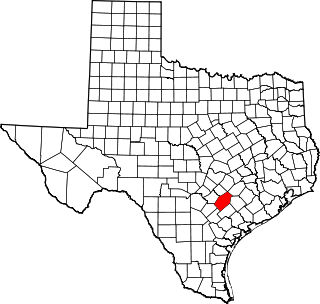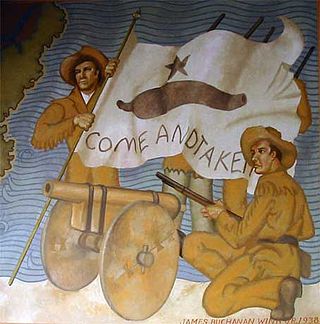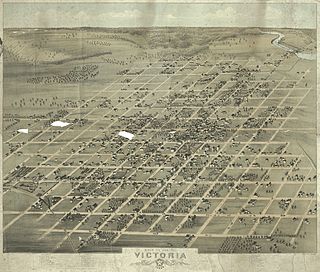
The Republic of Texas was a sovereign state in North America that existed from March 2, 1836, to February 19, 1846, that bordered Mexico, the Republic of the Rio Grande in 1840, and the United States of America, although Mexico considered it a rebellious province during its entire existence despite the Treaties of Velasco of May 1836. It was bordered by Mexico to the west and southwest, the Gulf of Mexico to the southeast, the two U.S. states of Louisiana and Arkansas to the east and northeast, and United States territories encompassing parts of the current U.S. states of Oklahoma, Kansas, Colorado, Wyoming, and New Mexico to the north and west. The Anglo residents of the area and of the republic became known as Texians.

Gonzales County is a county in the U.S. state of Texas, adjacent to Greater Austin-San Antonio. As of the 2020 census, its population was 19,653. The county is named for its county seat, the city of Gonzales. The county was created in 1836 and organized the following year. As of August 2020, under strict budgetary limitations, the County of Gonzales government-body is unique in that it claims to have no commercial paper, regarding it as "the absence of any county debt."

DeWitt County is a county located in the U.S. state of Texas. As of the 2020 census, its population was 19,824. The county seat is Cuero. The county was founded in 1846 and is named for Green DeWitt, who founded an early colony in Texas.

The Fredonian Rebellion was the first attempt by Anglo settlers in Texas to secede from Mexico. The settlers, led by Empresario Haden Edwards, declared independence from Mexican Texas and created the Republic of Fredonia near Nacogdoches. The short-lived republic encompassed the land the Mexican government had granted to Edwards in 1825 and included areas that had been previously settled. Edwards's actions soon alienated the established residents, and the increasing hostilities between them and settlers recruited by Edwards led Víctor Blanco of the Mexican government to revoke Edwards's contract.

The Battle of Gonzales was the first military engagement of the Texas Revolution. It was fought near Gonzales, Texas, on October 2, 1835, between rebellious Texian settlers and a detachment of Mexican army soldiers.

Coahuila y Tejas, officially the Estado Libre y Soberano de Coahuila y Tejas, was one of the constituent states of the newly established United Mexican States under its 1824 Constitution.

Mexican Texas is the historiographical name used to refer to the era of Texan history between 1821 and 1836, when it was part of Mexico. Mexico gained independence in 1821 after winning its war against Spain, which began in 1810. Initially, Mexican Texas operated similarly to Spanish Texas. Ratification of the 1824 Constitution of Mexico created a federal structure, and the province of Tejas was joined with the province of Coahuila to form the state of Coahuila y Tejas.

An empresario was a person who had been granted the right to settle on land in exchange for recruiting and taking responsibility for settling the eastern areas of Coahuila y Tejas in the early nineteenth century. The word in Spanish for entrepreneur is emprendedor.
The Convention of 1832 was the first political gathering of colonists in Mexican Texas. Delegates sought reforms from the Mexican government and hoped to quell the widespread belief that settlers in Texas wished to secede from Mexico. The convention was the first in a series of unsuccessful attempts at political negotiation that eventually led to the Texas Revolution.
The Consultation, also known as the Texian Government, served as the provisional government of Mexican Texas from October 1835 to March 1836 during the Texas Revolution. Tensions rose in Texas during early 1835 as throughout Mexico federalists began to oppose the increasingly centralist policies of the government. In the summer, Texians elected delegates to a political convention to be held in Gonzales in mid-October. Weeks before the convention and war began, the Texian Militia took up arms against Mexican soldiers at the Battle of Gonzales. The convention was postponed until November 1 after many of the delegates joined the newly organized volunteer Texian Army to initiate a siege of the Mexican garrison at San Antonio de Bexar. On November 3, a quorum was reached in San Antonio. Within days, the delegates passed a resolution to define why Texians were fighting. They expressed allegiance to the deposed Constitution of 1824 and maintained their right to form the General Council. In the next weeks, the council authorized the creation of a new regular army to be commanded by Sam Houston. As Houston worked to establish an army independent from the existing volunteer army, the council repeatedly interfered in military matters.

Green DeWitt was an empresario in Mexican Texas. He brought families from the United States to what is now South-central Texas and founded the DeWitt Colony.
Rafael Antonio Manchola was a politician and military officer in Mexican Texas. He twice served as commandant of Presidio La Bahía. He served two terms in the legislature of the state of Coahuila y Tejas. At his behest, the community which had grown outside the fort was renamed Goliad and elevated in status to a villa. During his legislative service, Manchola also negotiated official boundaries for the colony of his father-in-law, Martín De León, and had a commissioner appointed to grant official titles to the settlers in that colony. After returning home, Manchola became the alcade of Goliad and initiated a resolution–then considered illegal– supporting the Constitution of 1824 and Mexican President Antonio Lopez de Santa Anna. He briefly attended the Convention of 1832 and volunteered to accompany William H. Wharton in journeying to Mexico City to request separate statehood for Texas. The mission was postponed, and Manchola died of cholera in late 1832 or early 1833.
The Law of April 6, 1830 was issued because of the Mier y Terán Report to counter concerns that Mexican Texas, part of the border state of Coahuila y Tejas was in danger of being annexed by the United States. Immigration of United States citizens had begun to accelerate and the law specifically banned any additional American colonists from settling in Mexican Territory, which included California and Texas, along with the areas that would become Arizona, parts of Colorado, Nevada, New Mexico, and Utah. It also stopped the import of more slaves into Texas.
Plácido Benavides (1810–1837) was an early Mexican-born settler in De Leon's Colony, Victoria County, Texas. Benavides earned himself the sobriquet of the Paul Revere of Texas for his 1836 journey from San Patricio to Goliad to Victoria, warning residents of the approaching Mexican army. He was twice elected alcalde of Victoria, Texas. He married into the powerful De León family, and with his wife Agustina became the father of three daughters. Benavides fought against the dictatorship of Antonio López de Santa Anna, but did not feel Texas should be separated from Mexico.

De León's Colony was established in 1824 in the northern Coahuila y Tejas state of the First Mexican Republic, by empresario Martín De León. It was the only ethnically Mexican colony founded during the Mexican period (1824-1835) that is located within the present-day U.S. state of Texas.

Martín De León (1765–1833) was a rancher and wealthy Mexican empresario in Texas who was descended from Spanish aristocracy. He was the patriarch of one of the prominent founding families of early Texas. De León and his wife Patricia de la Garza established De León's Colony, the only predominantly Mexican colony in Texas. They founded the town of Villa de Nuestra Señora de Guadalupe Victoria Nombre de Jesús on the Guadalupe River. The name referred both to the river and to Mexico's president Guadalupe Victoria.

Matthew Caldwell,, also spelled Mathew Caldwell was a 19th-century Texas settler, military figure, Captain of the Gonzales – Seguin Rangers and a signer of the Texas Declaration of Independence. Because of his recruitment ride ahead of the Battle of Gonzales, some call him the Paul Revere of Texas.

Robertson's Colony was an empresario colonization effort during the Mexican Texas period. It is named after Sterling C. Robertson, but had previously been known by other names. It has also been referred to as the Nashville Colony, after the Tennessee city where the effort originated, the Texas Association, the Upper Colony, and Leftwich's Grant, named after early colonizer Robert Leftwich. The eventual contract spread over an area that includes all or part of thirty present-day counties in Texas.
James Hewetson was a Texas empresario.

The Lake Creek Settlement was a settlement in Stephen F. Austin's Second Colony, located in Mexican Texas, and later the Republic of Texas after it gained independence in 1836. The Lake Creek Settlement was located between the West Fork of the San Jacinto River (Texas) and the stream known as Lake Creek. It was the first Anglo-American settlement in what is today western Montgomery County, Texas.













